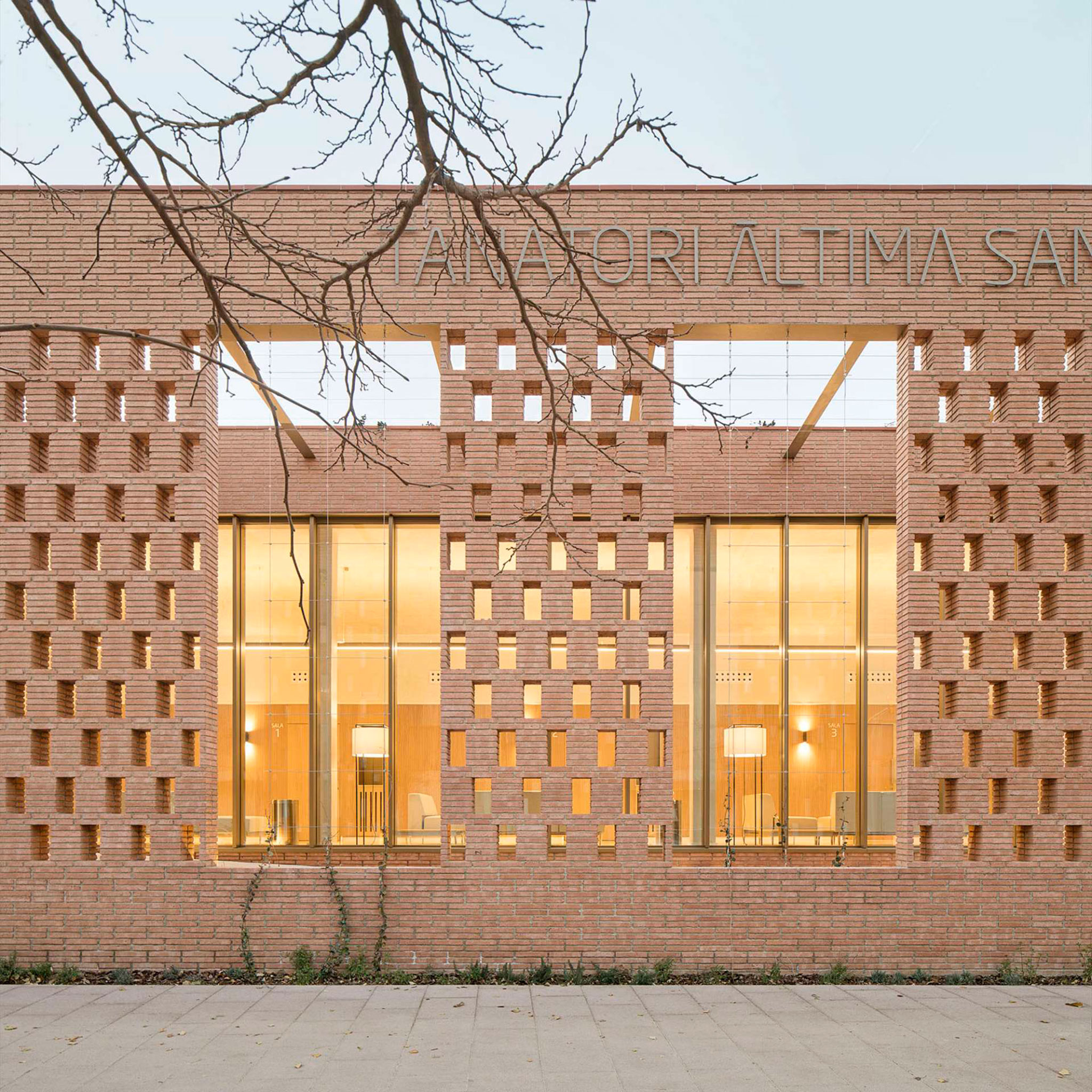
The project developed by Batlleiroig is organised around a main hall that leads to the four funeral rooms it has. Thanks to different patios and lattice-shaped openings, the building has different intensities of natural lighting that provide the complex with different environments according to the needs of the programme.
The envelope is resolved using eco-manual brick, which seeks affinities with the existing materials while developing in different ways, playing with its arrangement, depending on the needs of the building. In this way, the façade is closed in the areas that require more privacy and those that require a more intimate atmosphere, while it opens in the most public spaces to let in abundant natural light through large lattices.

Àltima Sant Andreu- Nou Barris Funeral Home by Batlleiroig. Photograph by Del Rio Bani.
Project description by Batlleiroig
The new Funeral Home Áltima Sant Andreu – Nou Barris is presented as a new facility for both districts, next to the Sant Andreu cemetery. The proposal seeks to integrate into the historical context of the place, enhancing and articulating a system of green spaces in the area.
Promote sustainable mobility
The proposal aims to emphasize the existing and future pedestrian routes in its urban environment, facilitating slow mobility connections through the consolidation of a network of green spaces.
In this way, the building not only responds to its current context but also lays the groundwork for future adaptation and connection of the open spaces, promoting sustainable mobility for the neighborhood.

Respect and enhance the environment
The main objective of the project is to respect and enhance the environment in which it is located, integrating into its context through a joint materiality with the perimeter wall of the cemetery, which turns the brick into a unitary element of the new complex formed by the funeral home and the cemetery.
The proposal seeks to dignify the Masia de Can Valent, a historic building currently in deterioration located in the work area. The project aims to create a new complex that dialogues between the different existing and new elements, creating unity and a common language.

Urban integration and materiality
The urban presence of the new facility is dominated by exposed brickwork that wraps around all the exterior faces of the building and its green roof. This new piece is attached to the perimeter wall of the cemetery and is conceived as a volume of simple forms that respect the regularity of its surroundings.
The envelope is resolved through an eco-manual brick, which seeks affinities with existing materials while developing in different ways by playing with the arrangement of its bond, depending on the needs of the building. The façade is closed in areas that require more privacy and those that require a more intimate atmosphere, while it opens in the most public spaces to let abundant natural light in through large-sized lattice screens.
In this way, the funeral home opens to the public space thanks to a latticework system created from its envelope, while technical areas are concentrated in the rear part, next to the cemetery wall, so that they never interfere with public use. The layout of interior patios offers natural light and improves the quality of interior spaces with the presence of biophilia.

Interior layout and light control
A ramp parallel to the main facade of the building, covered with numerous vines, provides access to the building, which is developed only on the ground floor. Its interior is distributed by a longitudinal hall that gives access to all public spaces.
The building consists of four viewing rooms accessed from the main vestibule. These rooms are composed of a toilet, a waiting room, and a room where the catafalque is located. Between the waiting room and the catafalque room, there is a courtyard that provides natural light to both spaces. For the noble areas, materials such as exposed concrete, bronze, or oak wood have been combined, resulting in spaces that are sober yet welcoming.

The interior courtyards are characterized by vegetation. Among other species, a central strip of bamboo has been placed to provide the necessary privacy to the room where the catafalque is located. This space is dimly lit, creating the appropriate atmosphere of solemnity.
The main space of the building is the chapel. It is a hexagonal room with an inclined exposed concrete floor covered in its vertical surfaces with grooved oak wood with two different patterns. These characteristics, along with the suspended luminaires and the marble altar, give the room the ceremonial atmosphere it requires. Finally, the space opens up through a large window to a triangular patio dominated by a Ginkgo Biloba, a tree symbolizing life and renewal.

Biodiversity and sustainability
The building incorporates some of the sustainability principles present in all Batlleiroig projects. In addition to the aforementioned sustainable mobility, it advocates for a construction where biodiversity and renewable energy production are the protagonists.
Vegetation colonizes all the exterior spaces of the intervention, making it a key element of the project, promoting biophilia, and generating well-being and comfort for users.
Regarding the building’s energy, it seeks to be self-sufficient through different passive systems, such as the use of louvers and vegetation to filter solar radiation, cross ventilation thanks to the different courtyards, and a green roof. Active systems such as photovoltaic panels have been installed on the building’s roof, ensuring that almost all the energy consumed comes from a renewable energy source.



















































